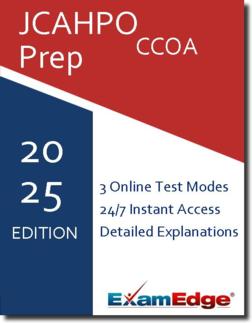JCAHPO CCOA (CCOA) Practice Tests & Test Prep by Exam Edge - Topics
Based on 40 Reviews
- Real Exam Simulation: Timed questions and matching content build comfort for your JCAHPO CCOA test day.
- Instant, 24/7 Access: Web-based JCAHPO Corporate Certified Ophthalmic Assistant practice exams with no software needed.
- Clear Explanations: Step-by-step answers and explanations for your JCAHPO exam to strengthen understanding.
- Boosted Confidence: Reduces anxiety and improves test-taking skills to ace your JCAHPO Corporate Certified Ophthalmic Assistant (CCOA).

Understanding the exact breakdown of the JCAHPO Corporate Certified Ophthalmic Assistant test will help you know what to expect and how to most effectively prepare. The JCAHPO Corporate Certified Ophthalmic Assistant has multiple-choice questions The exam will be broken down into the sections below:
| JCAHPO Corporate Certified Ophthalmic Assistant Exam Blueprint | ||
|---|---|---|
| Domain Name | % | Number of Questions |
| History Taking | 8% | 8 |
| Pupillary Assessment | 3% | 3 |
| Contact Lenses | 2% | 2 |
| Equipment Maintenance And Repair | 4% | 4 |
| Lensometry | 3% | 3 |
| Keratometry | 3% | 3 |
| Medical Ethics, Legal And Regulatory Issues | 5% | 5 |
| Microbiology | 2% | 2 |
| Pharmacology | 8% | 8 |
| Ocular Motility | 3% | 3 |
| Assisting In Surgical Procedures | 7% | 7 |
| Ophthalmic Patient Services & Education | 16% | 16 |
| Ophthalmic Imaging | 3% | 3 |
| Refractometry | 6% | 6 |
| Spectacle Skills | 3% | 3 |
| Supplemental Skills | 8% | 8 |
| Tonometry | 4% | 4 |
| Visual Assessment | 8% | 8 |
| Visual Fields | 4% | 4 |


